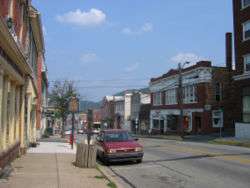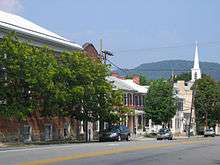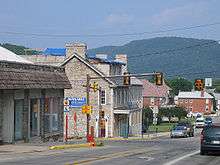Bedford, Pennsylvania
Bedford is a borough in and the county seat of Bedford County in the U.S. state of Pennsylvania.[4] It is located 102 miles (164 km) west of Harrisburg, the state capital, and 107 miles (172 km) east of Pittsburgh. Bedford's population was 2,841 at the 2010 census.[5]
Bedford, Pennsylvania | |
|---|---|
Borough | |
 East Pitt Street in Bedford | |
 Location of Bedford in Bedford County, Pennsylvania. | |
 Bedford Location in Pennsylvania  Bedford Bedford (the United States)  Bedford Bedford (North America) | |
| Coordinates: 40°00′59″N 78°30′15″W | |
| Country | United States |
| State | Pennsylvania |
| County | Bedford County |
| Settled | 1751 |
| Laid out | 1766 |
| Incorporated | March 13, 1795 |
| Government | |
| • Mayor | William "Bill" Leibfreid |
| Area | |
| • Total | 1.11 sq mi (2.88 km2) |
| • Land | 1.08 sq mi (2.81 km2) |
| • Water | 0.03 sq mi (0.07 km2) |
| Elevation | 1,100 ft (300 m) |
| Population (2010) | |
| • Total | 2,841 |
| • Estimate (2018)[2] | 2,707 |
| • Density | 2,510.60/sq mi (969.28/km2) |
| Time zone | UTC-5 (EST) |
| • Summer (DST) | EDT |
| Area code(s) | 814 Local phone exchanges: 623, 624 |
| FIPS code | 42-04944 |
| Website | bedboro |
| Official name | Bedford Village |
| Designated | November 06, 1982[3] |
History
Growing up around Fort Bedford, which had been constructed near the trading post called Raystown, Bedford was settled about 1751 and laid out in 1766. Bedford was incorporated on March 13, 1795.[6] For many years it was an important frontier military post. The Espy House in Bedford is notable for having been the headquarters of George Washington and his force of 13,000 while putting down the Whiskey Rebellion in 1794, which had started around the Jean Bonnet Tavern just west of Bedford.
In 1758 the British Army came to the vicinity of John Ray's trading post to set up Fort Bedford, named for the politically powerful Duke of Bedford in England. Some believe this is how the town later got its name. Fort Bedford was built as one of the many British Army stepping stones through the state leading to the forks of the Ohio River; the other side of the forks was dominated by Indians. The British used the fort to drive out the French to ensure the new continent would be British controlled. The fort was later a safe house for settlers escaping Indian raids. Fort Bedford was "liberated" ten years before the Revolution by American rebels, James Smith's Black Boys, and was the first fort taken from the British. The fort later collapsed; it was reconstructed in 1958.
George Washington marched his army to Bedford in 1794 to subdue the Whiskey Rebellion. There was much more at stake than quieting the uprising of rebels angered by a tax on whiskey; Washington felt the Constitution itself was at risk. The rebellion mainly consisted of farmers who could, due to the high cost of pack mule transport to the eastern cities, earn more selling whiskey instead of grain. The rebellion spread fast, and when it reached Pittsburgh some rebels threatened to burn the city to the ground. Anarchy was on its way; the British and French watched every move hoping they could come back and take over. Washington knew he had to act and make a statement; the laws of America would be obeyed. 12,950 militiamen were called to Bedford leaving the rebels without many choices. One historian later stated, "It was at Bedford that the new federal government was finally to establish itself as sovereign in its own time and place."
Bedford, at one time, was famous for its medicinal springs. There is a mineral spring, a chalybeate spring, a limestone spring, a sulfur spring and two sweet springs. In the year 1804, a mechanic from Bedford, Jacob Fletcher, drank some of the water. The rheumatic pains and ulcers he had been suffering from troubled him less that night. From then on he often drank from the spring and soaked his limbs in the water. In a few weeks he was entirely cured. News spread and the "healing springs" quickly became popular.

The discovery of the curative springs led Dr. John Anderson to purchase the nearby land and build a spa in 1804. Due to the lack of medicines in that time, people from great distances flocked to the hotel in search of a cure for their illness. The Bedford Springs Hotel was the first place in America to have an Olympic sized pool. President James Buchanan made it his "summer White House". While Buchanan was there the first trans-Atlantic cable message was sent to his room from Queen Victoria on August 17, 1858. The hotel, in 1855, also housed the only Supreme Court hearing ever to be held outside of the capital.
Chalybeate Springs Hotel, along with the nearby Bedford Springs Hotel, were popular resorts during the 19th century among the wealthy. Notable visitors to Bedford Springs included William Henry Harrison, James Polk, Zachary Taylor, and Thaddeus Stevens. Rutherford B. Hayes, and Benjamin Harrison visited Chalybeate Springs Hotel, as did many other notable people.[7]
U.S. Route 30, also known as the Lincoln Highway, passes through Bedford. Up until the opening of the Pennsylvania Turnpike in 1940, U.S. Route 30 was the key east-west route connecting Philadelphia to the west. In 1927, David Koontz built a coffee pot-shaped building, which was originally a diner. This building, a landmark in Bedford, was moved in 2003 to the Bedford County Fairgrounds.[8]
The Bedford Historic District was added to the National Register of Historic Places in 1983.[9]
Geography
Bedford is located in the center of Bedford County at 40°0′59″N 78°30′15″W (40.016361, −78.504071).[10] It is completely surrounded by Bedford Township.
The borough is accessible from Exit 146 of the Pennsylvania Turnpike at the midpoint between Harrisburg and Pittsburgh. U.S. Route 220 is a four-lane north-south highway that bypasses Bedford to the west and becomes Interstate 99 just north of town where it crosses the Pennsylvania Turnpike. US-220 Business passes through the center of Bedford as Richard Street. The Raystown Branch of the Juniata River, a tributary of the Susquehanna River, flows west to east through the center of Bedford.
According to the United States Census Bureau, the borough has a total area of 1.11 square miles (2.88 km2), of which 0.03 square miles (0.07 km2), or 2.51%, is water.[5]
Events
A Fall Foliage Festival is held in the beginning of October on the first two weekends of the month. The celebration stretches from Penn Street, down Juliana Street, to the park by the Fort Bedford Museum. The event includes many vendors, touring of the fort, the Children's Theater, pony rides, and an antique car show.
The Bedford County Fair takes place annually in July or August.[11] Alongside a classic midway of rides, games, and food vendors are a multitude of 4-H-sponsored events (including animal shows and livestock auctions), automobile racing, demolition derbies, and a petting zoo.[12] The automobile racing and demolition derbies take place at the Bedford Fairgrounds Speedway, adjacent to the remainder of the Fair.[13]
Demographics
| Historical population | |||
|---|---|---|---|
| Census | Pop. | %± | |
| 1800 | 257 | — | |
| 1810 | 547 | 112.8% | |
| 1820 | 789 | 44.2% | |
| 1830 | 869 | 10.1% | |
| 1840 | 1,022 | 17.6% | |
| 1850 | 1,203 | 17.7% | |
| 1860 | 1,328 | 10.4% | |
| 1870 | 1,247 | −6.1% | |
| 1880 | 2,011 | 61.3% | |
| 1890 | 2,242 | 11.5% | |
| 1900 | 2,167 | −3.3% | |
| 1910 | 2,235 | 3.1% | |
| 1920 | 2,330 | 4.3% | |
| 1930 | 2,953 | 26.7% | |
| 1940 | 3,268 | 10.7% | |
| 1950 | 3,521 | 7.7% | |
| 1960 | 3,696 | 5.0% | |
| 1970 | 3,302 | −10.7% | |
| 1980 | 3,326 | 0.7% | |
| 1990 | 3,137 | −5.7% | |
| 2000 | 3,141 | 0.1% | |
| 2010 | 2,841 | −9.6% | |
| Est. 2018 | 2,707 | [2] | −4.7% |
| Sources:[14][15][16] | |||
As of the census[15] of 2000, there were 3,141 people, 1,536 households, and 832 families residing in the borough. The population density was 2,830.8 people per square mile (1,092.6/km²). There were 1,640 housing units at an average density of 1,478.0 per square mile (570.5/km²). The racial makeup of the borough was 97.71% White, 0.51% African American, 0.06% Native American, 0.76% Asian, 0.10% Pacific Islander, 0.13% from other races, and 0.73% from two or more races. Hispanic or Latino of any race were 0.80% of the population.
There were 1,536 households, 21.2% had children under the age of 18 living with them, 42.3% were married couples living together, 9.6% had a female householder with no husband present, and 45.8% were non-families. 40.5% of households were made up of individuals, and 19.7% had someone living alone who were 65 or older. The average household size was 2.04 and the average family size was 2.76.
In the borough the population was spread out, with 18.8% under the age of 18, 7.5% from 18 to 24, 26.1% from 25 to 44, 24.8% from 45 to 64, and 22.8% 65 or older. The median age was 43 years. For every 100 females, there were 80.7 males. For every 100 females age 18 and over, there were 77.5 males.
The median household income was $28,549 and the median family income was $39,122. Males had a median income of $29,148 versus $21,375 for females. The per capita income for the borough was $18,028. About 8.5% of families and 11.9% of the population were below the poverty line, including 12.6% of those under age 18 and 7.7% of those age 65 or over.
Economy
Bedford has both Walmart and REI distribution centers, due to its close location to major highways and cities.
Transportation
Bedford County Airport is a public use airport in Bedford County. It is owned by the Bedford County Airport Authority and is located four nautical miles (7.4 km) north of the central business district of the borough of Bedford.
Media
Magazines
- Hometown Magazine
Newspapers
- Bedford Gazette
Television
Bedford receives television programming from the Johnstown-Altoona-State College, PA media market.
Notable people
- John Tod (1779-1830) – U.S. Congressman for Pennsylvania from 1821 to 1824
- Henry Woods (1764–1826) – U.S. Congressman for Pennsylvania from 1799 to 1803
See also
- Cannondale Bicycle Corporation—Cannondale had a factory in Bedford from 1983 until 2015.
References
- "2017 U.S. Gazetteer Files". United States Census Bureau. Retrieved March 24, 2019.
- "Population and Housing Unit Estimates". Retrieved December 2, 2019.
- "PHMC Historical Markers Search" (Searchable database). Pennsylvania Historical and Museum Commission. Commonwealth of Pennsylvania. Retrieved January 25, 2014.
- "Find a County". National Association of Counties. Archived from the original on July 4, 2012. Retrieved 2011-06-07.
- "Geographic Identifiers: 2010 Demographic Profile Data (G001): Bedford borough, Bedford County, Pennsylvania". U.S. Census Bureau, American Factfinder. Archived from the original on February 12, 2020. Retrieved February 28, 2014.
- Bedford County Pennsylvania Genealogy Project. "Bedford County History". Archived from the original on October 26, 2006.
- Bedford County Pennsylvania Genealogy Project. "Bedford County summer capital of the U.S." Archived from the original on October 26, 2006.
- Foster, Margaret (December 1, 2003). "Giant Coffee Pot Will Be Moved to Safety". Preservation Online. National Preservation Trust. Archived from the original on February 9, 2006.
- "National Register Information System". National Register of Historic Places. National Park Service. July 9, 2010.
- "US Gazetteer files: 2010, 2000, and 1990". United States Census Bureau. February 12, 2011. Retrieved April 23, 2011.
- "Bedford County Fair". Retrieved July 13, 2017.
- "Bedford County Fair". Retrieved July 13, 2017.
- "Bedford Speedway". bedfordspeedway.com. Retrieved July 13, 2017.
- "Census of Population and Housing". U.S. Census Bureau. Retrieved 11 December 2013.
- "U.S. Census website". United States Census Bureau. Retrieved 2008-01-31.
- "Incorporated Places and Minor Civil Divisions Datasets: Subcounty Resident Population Estimates: April 1, 2010 to July 1, 2012". Population Estimates. U.S. Census Bureau. Archived from the original on June 11, 2013. Retrieved 11 December 2013.
- Ned Frear, The Bedford Story: Fort Bedford (Pennsylvania: Gazette Publishing Company, 1998)
- Ned Frear, The Bedford Story: The Whiskey Rebellion (Pennsylvania: Gazette Publishing Company, 1998)
- Ned Frear, The Bedford Story: The Bedford Springs (Pennsylvania: Gazette Publishing Company, 1998)
- Carol Eddleman and Nathan Zipfel. "Bedford County Genealogy Project". Archived from the original on October 18, 2006. Retrieved October 11, 2006.
- History of Bedford, Somerset and Fulton Counties, (Chicago, 1884)
- History of Bedford and Somerset Counties, (New York, 1906)
External links
| Wikimedia Commons has media related to Bedford, Pennsylvania. |


